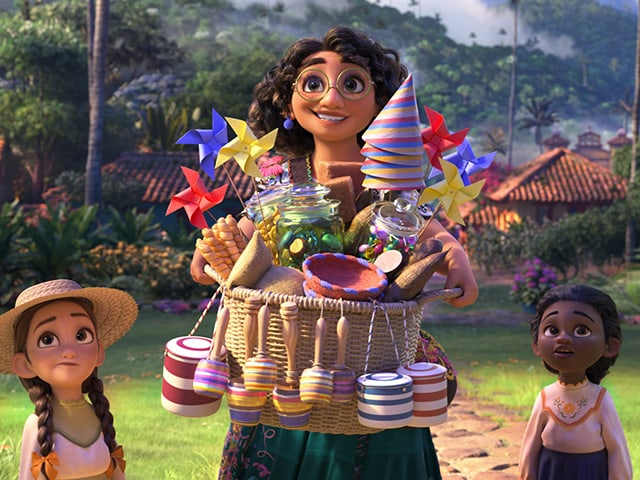
I have to hand it to Disney and Pixar. Two recent films, Encanto and Turning Red, not only feature entirely female main characters of color but offer re-scripting for both its teenage and adult leads. A throughline of both films is how perfectionism is as damaging to adult women as it is to teenage girls and how the legacy of intergenerational trauma, evinced through matrilineal control, hurts everyone.
Early on in Encanto, the main character, 15-year-old Mirabel sings, “Let’s be clear, Abuela runs the show” and indeed the elder, widowed young with baby triplets, rules with an iron fist. Evidence is everywhere how much pressure everyone is under—epitomized during Mirabel’s sister Luisa’s solo, “Surface Pressure,” which comes bursting out of her after she’s asked why her eye is constantly twitching. Mirabel’s Aunt Pepa (whose ‘gift’ is controlling the weather) is seen anxiously stroking her hair with a pained expression in an attempt to self-soothe so that clouds above her head will dissipate and not cause rain in the village.
What quickly becomes clear is how Abuela’s constant refrain, “Think of the family!”—an edict to use their gifts in service of others—is fraying everyone’s nerves. Early in the film, Mirabel’s sister Isabella is seen walking with arm in arm with Abuela who tells her, like a monarch explaining her duty to be a marriage pawn, how becoming engaged to her approved suitor Mariano will create a perfect annexing of their families. She smiles, but when things reach a breaking point (literally and otherwise), she reveals she never wanted to marry him anyway, but was doing it ‘for the family’—a big admission, especially since her cousin Dolores’s super-sonic ears picked up that that Mariano wants five babies.
The subjugation of women’s desires under the rule of an imperious matriarch is mirrored in Turning Red, in this case more through the suppression of anger or otherwise ‘unfeminine’ behavior—including pushback to a mother. The main character Meilin “Mei” breaks with this tradition. That a teenage girl is the family member brave enough to reverse a pattern of repression is strikingly similar in both films and a bold statement, particularly as they bring their mothers around, or rather out from under, behaviors that hurt their generation yet they replicate.
Abuela is furious when Isabella’s rebellion clashes with her expectation of a perfect union and reign of control. She’s also clear that Mirabel, who wasn’t given a magical gift (to be co-opted into selfless service for their community), is a source of disappointment. Yet, by the film’s end, Abuela (rather suddenly) admits she had such fear about losing their family—as she once did her husband—she ‘held on too tight’ and can admit how damaging this mask of ‘everything’s fine’ has been as she concerned herself only with her family’s reputation, status and image.
A podcaster I listen to recently mentioned the proliferation of “middle-aged moms rage-singing on TikTok” to the catchy (ear worm) song “We Don’t Talk About Bruno” and I see why: the idea of a family member who doesn’t fit being shunned, and the fear instilled in those remaining that the same will happen to them—never mind the relentless pressure to perform to family expectation. What family doesn’t know this dynamic? It also seems like a script for modern motherhood.

While the story line of Turning Red is different, Pixar is on a parallel mission. A radical move comes early on through the openness of Ming, Mei’s mother, assuming (within the first 15 minutes of the film) that she’s gotten her first period, then unapologetically bringing her pads at school.
Yet, I can’t but hear the title as a reference to anger. So much of the film is about ‘letting the panda out,’ interpreted as metaphorically un-yoking from the stereotypical ‘good girl’ behavior Ming is locked into: perfect grades, coming straight home from school, obedience to her parents, to duty, to caring for their family’s temple.
When Mei finally stands up to her mother (when they are both in panda form), she taunts her by gyrating in a series of dance moves and backing her (panda) butt up into her mom’s face—the offense of which is so great her mother backs away from the mere vision.
“Unleashing the panda” is presented to Mei as an adolescent rite all the women in their family go through followed by a ceremony with the expected outcome of containment. Ming’s mother instructs her that her granddaughter Mei “needs a strong hand” before her ceremony to not “let her out of your sight.” The familial investment in Mei’s return to ‘normalcy,’ which means repression of strong emotion and restoration of conformity, is palpable, which is why her later refusal comes as a generational shock.
Mei’s comment at the movie’s end to her mother “my panda, my choice” echoes the feminist phrase, “my body, my choice” and signals newfound bodily autonomy.
The visual presentation of an alter ego—the panda—and unleashing feelings of anger or aggression or even just un-self-conscious playfulness contrasted with conformity—becomes a dichotomy between stereotypically acceptable and ‘unacceptable’ female behavior. Mei’s father reveals how powerful Ming’s panda once was and alludes to her tight control (of herself as well as her daughter) as an anxious contrast to what else is so deeply held in.
When one of Mei’s supportive friends suggests she ‘keep the panda,’ the idea takes hold. While in a circle ceremony to capture and contain the pandas for all her female relatives, Mei watches them one by one give up their fierce animal alter-egos, then decides to remain hybrid—able to morph between human and panda form. Her comment at the movie’s end to her mother “my panda, my choice” echoes the feminist phrase, “my body, my choice” and signals newfound bodily autonomy.
There seems a way to read this decision as a nod to animal rights politics or a nonbinary plurality that might map with gender fluidity except with creaturely form. That her mother accepts this—and seems cheerily loosened up herself—is when the movie comes full circle from the powerful control she kept and vigilance about Mei’s changing body at the start of the film.
The teenage girl has always been a volatile figure—transforming physically and on multiple other levels. In both films, Disney and Pixar herald their main characters’ abilities to navigate family systems and crack open arrangements that belie the truth.
In Encanto, a film where family members transmogrify with their special gifts, 15-year-old Mirabel, the ‘ungifted’ one holds the power to recast tradition’s importance, and free her older family members, most significantly, its matriarch, from a damaging lockhold.
In Turning Red 13-year-old Mei upends the denial of the panda—incorporating it holistically as she shape shifts—and resets her mother’s life and their relationship as well.
Both films have had their share of criticism, more so Turning Red, with critiques that its characters have been “too narrow.” But with a range of female body types in both films, and teenage girls who fight for and claim their agency in radical ways, they also offer new freedom to their mothers, grandmothers and extended family by rescripting gendered expectations.
Up next:





